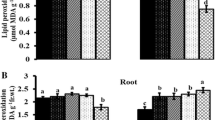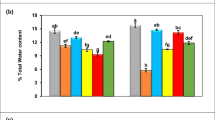Abstract
In this study, two cultivars of Brassica napus L. viz., Okapi (drought sensitive) and Zarfam (drought tolerant) were evaluated for their response to drought stress at physiological and molecular levels. Physiological drought stress was imposed on 10-day-old seedlings grown in half MS medium containing 200 mM mannitol at 0, 3, 12 and 24 h. At physiological level, water deficit changed ascorbate peroxidase, peroxidase and catalase activities in both the cultivars. However, the magnitude of changes differed in roots and shoots and was also genotype specific. Drought stress caused change in lipid peroxidation in terms of malondialdehyde (MDA) accumulation, soluble sugar and total protein contents in two cultivars with Zarfam responding earlier (3 h) compared to Okapi (12 h). At molecular level, there were significant variations between two cultivars in response to drought stress. Drought stress significantly up-regulated Auxin responsive protein (ARP), MPK3, Protein kinase (PK) and MPK4 genes transcript level in Okapi, while down-regulated expression in Zarfam. It can be concluded that drought stress imposed adverse effects on both cultivars by exertion of different responses.







Similar content being viewed by others
References
Abdullah, A., & Ghamdi, A. L. A. (2009). Evaluation of oxidative stress in two wheat (Triticum aestivum) cultivars in response to drought. International Journal of Agricultural Biology, 11, 7–12.
Abedi, T., & Pakniyat, H. (2010). Antioxidant enzyme changes in response to drought stress in ten cultivars of oilseed rape (Brassica napus L.). Czech Journal of Genetics and Plant Breeding, 46, 27–34.
Aebi, H. (1984). Catalase in vitro. In L. Packer (Ed.), Methods in enzymology (pp. 121–126). San Diego, CA: Academic Press Inc.
Akcay, U. C., Ercan, O., Kavas, M., Yildiz, L., Oktem, H. A., & Yucel, M. (2010). Drought-induced oxidative damage and antioxidant responses in peanut (Arachis hypogaea L.) seedlings. Plant Growth Regulations, 61, 21–28.
Albarrak, K. H. (2006). Irrigation interval and nitrogen level effects on growth and yield of canola (Brassica napus L.). Scientific Journal of King Faisal University, 7, 87–99.
Ashraf, M., & Mehmood, S. (1989). Response of four Brassica species to drought stress. Environmental and Experimental Botany, 30, 93–100.
Bañuelos, G. S., Bryla, D. R., & Cook, C. G. (2002). Vegetative production of kenaf and oilseed rape under irrigation in central California. Industrial Crops and Products, 15, 237–245.
Bishnoi, S. K., Kumar, B., Rani, C., Datta, K. S., Kumar, P., Sheoran, I. S., et al. (2006). Changes in protein profile of pigeonpea genotypes in response to NaCl and boron stress. BiologiaPlantarum, 50, 135–137.
Chen, L., Ren, F., Zhong, H., Jiang, W., & Li, X. (2010). Identification and expression analysis of genes in response to high-salinity and drought stresses in Brassica napus. Acta Biochimica et Biophysica Sinica, 42, 154–164.
Chinnusamy, V., Schumaker, K., & Zhu, J. K. (2004). Molecular genetic perspectives on cross-talk and specificity in abiotic stress signaling in plants. Journal of Experimental Botany, 55, 225–236.
DaCosta, M., & Huang, B. (2007). Changes in antioxidant enzyme activities and lipid peroxidation for Bentgrass species in response to drought stress. Journal of American Society of Horticulture Science, 132, 319–326.
Desikan, R., Mackerness, A. H. S., Hancock, J. T., & Neill, S. J. (2001). Regulation of the Arabidopsis transcriptome by oxidative stress. Plant Physiology, 127, 159–172.
Gueta-Dahan, Y., Yaniv, Z., Zilinskas, B. A., & Ben-Hayyim, G. (1997). Salt and oxidative stress: similar and specific responses and their relation to salt tolerance in citrus. Planta, 203, 460–469.
Heath, R. L., & Packer, L. (1968). Photo peroxidation in isolated chloroplasts. Archives of Biochemistry and Biophysics, 125, 850–857.
Hirayama, T., & Shinozaki, K. (2010). Research on plant abiotic stress responses in the post-genome era: past, present and future. The Plant Journal, 61, 1041–1052.
Khanna-Chopra, R., & Selote, D. S. (2007). Acclimation to drought stress generates oxidative stress tolerance in drought-resistant than -susceptible wheat cultivar under field conditions. Environmental and Experimental Botany, 60, 276–283.
Kochert, G. (1978). Carbohydrate determination by phenol-sulfuric acid method. In J. A. Hellebust & J. S. Craige (Eds.), Handbook of physiological and biochemical methods (pp. 95–97). London: Cambridge University Press.
Kovtun, Y., Chiu, W. L., Tena, G., & Sheen, J. (2000). Functional analysis of oxidative stress-activated mitogen-activated protein kinase cascade inplants. Proceedings of the National Academy of Sciences, 97, 2940–2945.
Larcher, W. (2003). Physiological plant ecology: Ecophysiology and stress physiology of functional groups (p. 513). Berlin: Springer.
Lehti-Shiu, M. D., & Shiu, S. H. (2012). Diversity, classification and function of the plant protein kinase super-family. Philosophical Transactions of Royal Society B, 367, 2619–2639.
Lowry, O. H., Rosenbrough, N. J., Farr, A. L., & Randall, R. J. (1951). Protein measurement with the Folin-phenol reagent. The Journal of Biological Chemistry, 193, 265–275.
Mariana, N., Norfarrah, M., Nik, K., Yusoff, F., & Arshad, A. (2009). Evaluating the antibacterial activity and in vivo assay of methanolic extract of Stichopus badionotus. International Journal of Pharmaceutics, 5, 228–231.
Mirzaee, M., Moieni, A., & Ghanati, F. (2013). Effects of drought stress on the lipid peroxidation and antioxidant enzyme activities in two canola (Brassica napus L.) cultivars. Journal of Agricultural Science and Technology, 15, 593–602.
Mittler, R. (2002). Oxidative stress, antioxidants and stress tolerance. Trends in Plant Science, 7, 405–410.
Mittova, V., Volokita, M., Guy, M., & Tal, M. (2000). Activities of SOD and the ascorbate-glutathione cycle enzymes in subcellular compartments in leaves and roots of the cultivated tomato and its wild salt-tolerant relative Lycopersicon pennellii. Physiologia Plantarum, 110, 42–51.
Mizoguchi, T., Irie, K., Hirayama, T., Hayashida, N., Yamaguchi-Shinozaki, K., Matsumoto, K., et al. (1996). A gene encoding a mitogen activated protein kinase kinase kinase is induced simultaneously with genes for a mitogen-activated protein kinase and an S6 ribosomal protein kinase by touch, cold, and water stress in Arabidopsis thaliana. Proceedings of the National Academy of Sciences, 93, 765–769.
Moussa, H., & Abdel-Aziz, S. M. (2008). Comparative response of drought tolerant and drought sensitive maize genotypes to water stress. Australian Journal of Crop Science, 1, 31–36.
Muhammad, N., Cheema, M. A., Wahid, M. A., Ahmad, N., & Zaman, M. (2007). Effect of source and method of nitrogen fertilizer application on seed yield and quality of canola (Brassica napus L.). Pakistan Journal of Agricultural Sciences, 44, 74–78.
Murashige, T., & Skoog, F. A. (1962). Revised medium for rapid growth and bioassays with tobacco cultures. Physiologia Plantarum, 159, 473–479.
Nair, A. S., Abraham, T. K., & Jaya, D. S. (2008). Studies on the changes in lipid peroxidation and antioxidants in drought stress induced cowpea (Vigna unguiculata L.) varieties. Journal of Environmental Biology, 29, 689–691.
Nakagami, H., Pitzschke, A., & Hirt, H. (2005). Emerging MAP kinase pathways in plant stress signaling. Trends Plant Science, 10, 339–346.
Nakano, Y., & Asada, K. (1981). Hydrogen peroxide is scavenged by ascorbate specific peroxidase in spinach chloroplasts. Plant and Cell Physiology, 22, 867–880.
Ohashi, Y., Nakayama, N., Saneoka, H., & Fujita, K. (2006). Effects of drought stress on photosynthetic gas exchange, chlorophyll fluorescence and stem diameter of soybean plants. Biology of Plant, 50, 138–141.
Ozkur, O., Ozdemir, F., Bor, M., & Turkan, I. (2009). Physiochemical and antioxidant responses of the perennial xerophyte Cappari sovata Desf. to drought. Environmental and Experimental Botany, 66, 487–492.
Pedley, K. F., & Martin, G. B. (2005). Role of mitogen-activated protein kinases in plant immunity. Current Opinion in Plant Biology, 8, 541–547.
Sairam, R. K., Veerabhadra Rao, K., & Srivastava, G. C. (2002). Differential response of wheat genotypes to long term salinity stress in relation to oxidative stress, antioxidant activity and osmolyte concentration. Plant Science, 163, 1037–1046.
Sanchez-Rodriguez, E., Rubio-Wilhelmi, M., Cervilla, L. M., Blasco, B., Rios, J. J., Rosales, M. A., et al. (2010). Genotypic differences in some physiological parameters symptomatic for oxidative stress under moderate drought in tomato plants. Plant Science, 178, 30–40.
Satterlee, J. S., & Sussman, M. R. (1998). Unusual membrane-associated protein kinases in higher plants. Journal of Membrane Biology, 164, 205–213.
Shao, H. B., Chu, L. Y., Wu, G., Zhang, J. H., Lu, Z. H., & Hu, Y. C. (2007). Changes of some anti-oxidative physiological indices under soil water deficits among 10 Wheat (Triticum aestivum L.) genotypes at tillering stage. Colloids and Surfaces B, Biointerfaces, 54, 143–149.
Shirani Rad, A. H., Naeemi, M., & Nasr Esfahani, S. H. (2010). Evaluation of terminal drought stress tolerance in spring and winter rapeseed genotypes. Iranian Journal of Crop Sciences, 12, 112–126. (in Persian).
Sl, H., Chao, Y. C., Tong, W. F., & Yu, S. M. (2001). Sugar coordinately and differentially regulates growth- and stress-related gene expression via a complex signal transduction network and multiple control mechanisms. Plant Physiology, 125, 877–890.
Sofo, A., Manfreda, S., Dichio, B., & Xiloyannis, C. (2008). The olive tree: A paradigm for drought tolerance in Mediterranean climates. Hydrology Earth Systematic Science, 12, 293–301.
Sreenivasulu, N., Grimm, B., Wobus, U., & Weschke, W. (2000). Differential response of antioxidant compounds to salinity stress in salt-tolerant and salt sensitive seedlings of foxtail millet (Setaria italica). Physiologia Plantarum, 109, 435–442.
Stone, J., & Walker, J. C. (1995). Plant protein kinase families and signal transduction. Plant Physiology, 108, 451–457.
Tas, S., & Tas, B. (2007). Some physiological responses of drought stress in wheat genotypes with different ploidity in Turkiye. World Journal of Agricultural Sciences, 3, 178–183.
Valliyodan, B., & Nguyen, H. (2006). Understanding regulatory networks and engineering for enhanced drought tolerance in plants. Current Opinion in Plant Biology, 9, 1–7.
Wang, W. B., Kim, Y. H., Lee, H. S., Kim, K. Y., Deng, X. P., & Kwak, S. S. (2009). Analysis of antioxidant enzyme activity during germination of alfalfa under salt and drought stress. Plant Physiology and Biochemistry, 47, 570–577.
Yordanov, I., Velikova, V., & Tsonev, T. (2000). Plant responses to drought, acclimation and stress tolerance. Photosynthetica Journal, 38, 171–186.
Yu, S. H., Zhang, L., Zuo, K., Tang, D., & Tang, K. (2005). Isolation and characterization of an oilseed rape MAP kinase, BnMPK3 involved in diverse environmental stresses. Plant Science, 169, 413–421.
Zhou, R., & Zhao, H. (2004). Seasonal pattern of antioxidant enzyme system in the roots of perennial forage grasses grown in alpine habitat, related to freezing tolerance. Physiologia Plantarum, 121, 399–408.
Acknowledgments
The authors would like to express their sincere thanks to Urmia Institute of Biotechnology for providing the desired facilities.
Author information
Authors and Affiliations
Corresponding author
Ethics declarations
Conflict of interest
The authors declare that they have no conflict of interest.
Rights and permissions
About this article
Cite this article
Rahmani, F., Padervand, AH. Differential response to physiological drought stress in tolerant and susceptible cultivars of canola. Ind J Plant Physiol. 21, 333–340 (2016). https://doi.org/10.1007/s40502-016-0239-y
Received:
Accepted:
Published:
Issue Date:
DOI: https://doi.org/10.1007/s40502-016-0239-y




